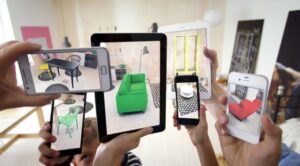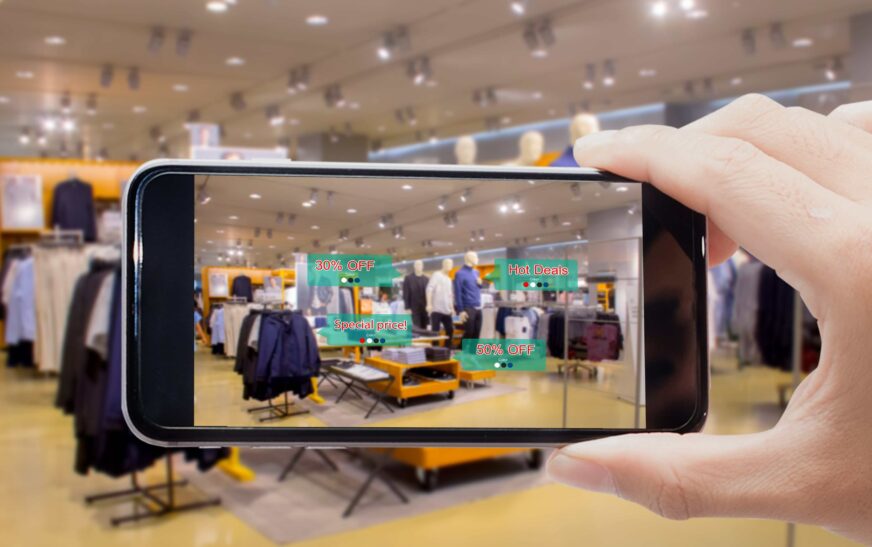Imagine stepping into a store and instantly trying on clothes without ever leaving your home. Picture scanning furniture with your phone, only to see how it looks in your living room before buying. Augmented reality shopping is transforming the retail experience, bringing a blend of digital innovation and physical interaction that’s never been seen before. As consumers seek immersive experiences, retailers are evolving their strategies to keep pace with this demand. The rise of augmented reality is not just a trend; it’s changing how we shop and interact with products. Dive into this new frontier where technology meets convenience, reshaping our understanding of retail forever.
The Rise of Augmented Reality in the Retail Industry
The retail industry is experiencing a digital revolution. Augmented reality (AR) is at the forefront, altering how brands connect with consumers. This technology layers digital information onto the physical world, creating interactive shopping experiences.
From cosmetic applications that let users virtually apply makeup to furniture retailers allowing customers to visualize products in their homes, AR bridges the gap between online and offline shopping. Shoppers can now engage with items like never before.
With smartphones becoming ubiquitous, more retailers are integrating AR into their strategies. Major brands recognize its potential for enhancing customer engagement and increasing sales.
As consumer expectations shift toward personalized experiences, augmented reality steps up as a powerful tool that caters to these desires seamlessly. Retailers investing in this technology stand out from the competition by offering unique ways for shoppers to experience products firsthand.
Benefits of Augmented Reality Shopping for Consumers
 Imagine trying on clothes without stepping into a fitting room. Augmented reality shopping makes it possible. Consumers can visualize how products will look and fit, right from their devices.
Imagine trying on clothes without stepping into a fitting room. Augmented reality shopping makes it possible. Consumers can visualize how products will look and fit, right from their devices.
This technology bridges the gap between online and offline shopping. Shoppers can see 3D images of items in real-time, enhancing confidence in their choices.
AR also saves time. No more long lines or endless searches through crowded aisles. With just a swipe or a tap, users find exactly what they want.
Additionally, personalization is at its peak with AR. Brands can create tailored experiences based on individual preferences, making each visit unique and engaging.
This tech creates an interactive adventure that transforms mundane shopping trips into exciting explorations filled with possibilities for every consumer.
Advantages of Augmented Reality for Retailers
 Augmented reality offers retailers a fresh way to connect with their audience. By integrating AR technology, brands can create immersive experiences that captivate shoppers. This engagement often leads to increased sales.
Augmented reality offers retailers a fresh way to connect with their audience. By integrating AR technology, brands can create immersive experiences that captivate shoppers. This engagement often leads to increased sales.
Another significant advantage is the reduction of product returns. Customers who use AR tools can visualize products in real-time, ensuring they choose what truly fits their needs and preferences. This not only enhances satisfaction but also streamlines inventory management for retailers.
Additionally, AR facilitates personalized marketing strategies. Retailers can tailor experiences based on customer interactions, making shopping more relevant and enjoyable.
Investing in augmented reality also sets brands apart from competitors. It showcases innovation and a commitment to enhancing the customer journey, attracting tech-savvy consumers eager for modern shopping solutions.
How Augmented Reality is Enhancing the Retail Experience
Augmented reality (AR) is transforming how we shop, making the experience more interactive and personalized. Imagine walking into a store and seeing virtual overlays that provide information about products. This technology bridges the gap between online convenience and in-store engagement.
Shoppers can visualize items in their own space before committing to a purchase. For instance, furniture retailers offer apps allowing customers to place digital sofas or tables within their homes via smartphone cameras.
Dressing rooms have also evolved. Virtual fitting rooms let consumers try on clothes without changing outfits physically, saving time while enhancing comfort.
Gamification elements are becoming commonplace too. Retailers create AR experiences where customers participate in challenges or treasure hunts for discounts, making shopping feel like an adventure rather than a chore.
These innovations not only enrich customer interactions but also foster brand loyalty by offering unique experiences tailored to individual preferences.
Examples of Successful AR Shopping Implementations
IKEA has taken the lead with its IKEA Place app. Users can visualize furniture in their homes before making a purchase. This not only saves time but also minimizes buyer’s remorse.
Sephora has embraced augmented reality through its Virtual Artist feature. Shoppers can try on makeup virtually, allowing them to experiment with different looks without any mess or commitment.
L’Oreal launched an AR tool that lets customers test hair colors and cosmetics in real-time. It’s interactive and fun, providing instant feedback on how products might look.
Nike introduced an AR experience that allows customers to scan shoes using their smartphones. They can see additional details like fit recommendations and even access styling tips directly from the app.
These implementations show how creativity intersects with technology, reshaping shopping experiences for consumers everywhere.
Challenges and Limitations of Augmented Reality Shopping
Despite its potential, augmented reality shopping faces several challenges. One major hurdle is the technology itself. Not all consumers own devices capable of fully supporting AR experiences.
User experience can also vary significantly. Some shoppers may find AR applications complicated or frustrating to navigate. A seamless integration with existing systems is crucial and often lacking.
Additionally, there are concerns about data privacy. Consumers worry about sharing personal information while engaging in AR environments. Retailers must address these issues carefully to build trust.
Cost remains another barrier for many businesses looking to implement AR solutions. Developing high-quality content requires significant investment and ongoing maintenance.
Internet connectivity plays a critical role in the success of augmented reality shopping experiences. Slow connections can detract from user engagement, limiting the effectiveness of the technology in retail settings.
The Future of AR Shopping and its Impact on the Retail Industry
The future of augmented reality shopping is brimming with potential. As technology advances, we can expect even more immersive experiences for consumers.
Imagine walking through a store and having virtual guides assist you in real-time. Personalized recommendations based on your preferences could pop up as you browse. This level of interaction will redefine customer engagement.
Retailers are likely to harness data analytics alongside AR tech to understand consumer behavior better. By analyzing how users interact with products virtually, businesses can tailor their offerings effectively.
Moreover, the incorporation of AR into e-commerce platforms will streamline online shopping. Customers may visualize items in their own spaces before purchasing, reducing returns and enhancing satisfaction.
As AR becomes mainstream, it might not only influence buying habits but also reshape brand loyalty dynamics. Shoppers could develop deeper connections with brands that leverage innovative technologies creatively and thoughtfully.
Conclusion
The integration of augmented reality into shopping is undeniably transforming the retail landscape. As consumers increasingly seek immersive and personalized experiences, AR provides a unique solution that meets these demands. Retailers who embrace this technology stand to gain not only in customer satisfaction but also in sales opportunities.
Looking ahead, the potential for continued innovation is vast. With advancements in AR technology and increasing consumer acceptance, we can expect more retailers to incorporate these tools into their shopping strategies.
Augmented reality is changing how we shop and interact with brands, making it an exciting time for both consumers and retailers alike. The future of retail will likely be defined by a seamless blend of digital enhancements that elevate the overall experience while meeting evolving consumer expectations.










